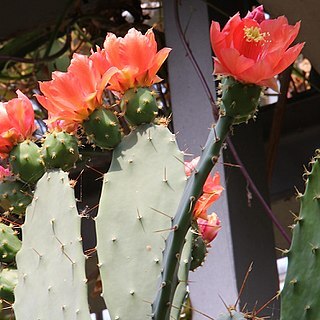Erect shrub 2–5 m high, to 8 m diam., often with a distinct trunk, the trunk to 1.7 m high and 18 cm diam. in older plants. Stem segments firmly attached, obovate or narrow-elliptic, 12–40 cm long, 6–20 cm wide, 9–12 mm thick, compressed, with sinuate margin, not tuberculate, smooth, grey-green to glaucous, dull, glabrous. Areoles 15–35 per stem segment face, (15–) 30–50 mm apart, circular or subcircular, 4–6 mm wide, not raised, with wool pale brown. Leaves succulent, terete, acuminate apex, often strongly recurved, 3–4 mm long, caducous. Spines (1) 2–3 (–6) per areole, erect, spreading or deflexed, the longer spines 20–45 mm long, 0.7–1 mm wide at base, ± flattened to ± terete in cross-section, straight, pale yellowish brown, or mottled yellow or red-brown, ageing brown or white, often with 1 or 2 shorter, more slender spines to 4 mm long. Glochids in a dense tuft, to 1.5–2.5 mm long, pale yellow-brown. Flowers 30–50 mm diam.; outer tepals reddish, brownish green towards basal centre or yellow green with orange red centre or green with outer tepals green, transitional ones orange with a green centre, succulent, triangular, the apex acute; inner tepals deep red or orange-red or orange-pink, only slightly spreading, obovate, 30–40–mm long, 23–26 mm wide, the apex obtuse, entire, with short mucro; staminal filaments pale yellow below and red above or pale pink, anthers pale yellow; style white or pale creamish yellow, stigma lobes light green or yellowish green; pericarpel (at anthesis) not tuberculate, with 1 or 2, short, slender spines present on occasional areoles. Fruit solitary, not proliferating, obovoid, (18–) 25–45 mm long, 20–30 mm diam., tuberculate, umbilicus deep, spineless, carmine, succulent, not edible. Seeds 4 mm diam.
More
Densely branched shrubs to 5 m. tall, the young stem joints narrowly obovate to suborbicular, to 4 dm. long, olive-green, the areoles 2-4 cm. apart, minutely hairy and with 1-8 unequal, terete-acicular brown black-tipped spines 1-7 cm. long. Flowers about 5 cm. in diameter, deep yellow more or less tinged with red or salmon, the inner segments obovate, mucronate, about 2 cm. long; staminal
A cactus. It is shrubby and forms clumps. They can be 5 m high. The stem segments are oblong and olive green. They are 10-40 cm long. There are 2-8 spines which are like needles and dark brown. They are 2-7 cm long. The flowers are yellow with red stripes. They are 5 cm across. The fruit are oval and red. They are fleshy.
filaments 1.5-2.0 cm. long, deeply tinged with red or salmon, yellow toward the base; ovary obovoid-turbinate, about 2 cm. long and broad, the areoles unarmed or nearly so. Berry obovoid, truncate, 4-5 cm. long, deep red when ripe.
In Australia, Opuntia elatior is predominantly naturalised in the subarid and arid inland regions, but also occurs in temperate regions such as in Melbourne. In Western Australia it has been collected from mulga woodland, on stony red loam along a drainage line, and along streams. In the Northern Territory it has been collected from the base of a rocky sandstone hill. The species is more widespread in South Australia, and has been collected from a dune on a pastoral station near a homestead, rocky outcrops, and near homesteads. In Queensland it is known from a single collection from a heavily grazed paddock, on cracking black clay, on the Condamine flood plain. In New South Wales it has been collected from open forest, and in Victoria, known at a single site on a road cutting at Studley Park in Melbourne, where evidently established from cultivated plants above road cutting.
More
A tropical plant. In the Himalayas it grows up to 2,000 m above sea level.


